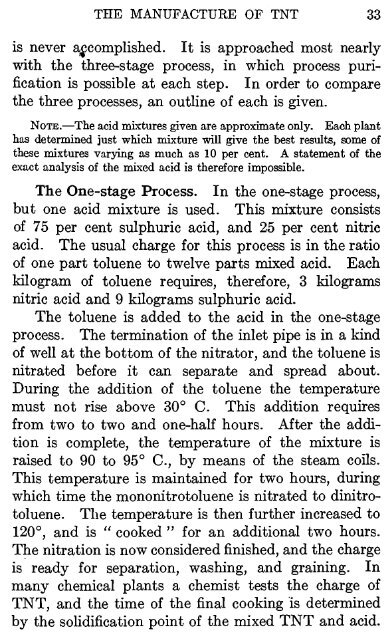TNT: Trinitrotoluenes and Mono and Dinitrotoluenes
TNT: Trinitrotoluenes and Mono and Dinitrotoluenes
TNT: Trinitrotoluenes and Mono and Dinitrotoluenes
You also want an ePaper? Increase the reach of your titles
YUMPU automatically turns print PDFs into web optimized ePapers that Google loves.
THE MANUFACTURE OF <strong>TNT</strong> 33<br />
is never accomplished. It is approached most nearly<br />
with the three-stage process, in which process purification<br />
is possible at each step. In order to compare<br />
the three processes, an outline of each is given.<br />
NOTE.—The acid mixtures given are approximate only. Each plant<br />
has determined just which mixture will give the best results, some of<br />
these mixtures varying as much as 10 per cent. A statement of the<br />
exact analysis of the mixed acid is therefore impossible.<br />
The One-stage Process. In the one-stage process,<br />
but one acid mixture is used. This mixture consists<br />
of 75 per cent sulphuric acid, <strong>and</strong> 25 per cent nitric<br />
acid. The usual charge for this process is in the ratio<br />
of one part toluene to twelve parts mixed acid. Each<br />
kilogram of toluene requires, therefore, 3 kilograms<br />
nitric acid <strong>and</strong> 9 kilograms sulphuric acid.<br />
The toluene is added to the acid in the one-stage<br />
process. The termination of the inlet pipe is in a kind<br />
of well at the bottom of the nitrator, <strong>and</strong> the toluene is<br />
nitrated before it can separate <strong>and</strong> spread about.<br />
During the addition of the toluene the temperature<br />
must not rise above 30° C. This addition requires<br />
from two to two <strong>and</strong> one-half hours. After the addition<br />
is complete, the temperature of the mixture is<br />
raised to 90 to 95° C, by means of the steam coils.<br />
This temperature is maintained for two hours, during<br />
which time the mononitrotoluene is nitrated to dinitrotoluene.<br />
The temperature is then further increased to<br />
120°, <strong>and</strong> is " cooked " for an additional two hours.<br />
The nitration is now considered finished, <strong>and</strong> the charge<br />
is ready for separation, washing, <strong>and</strong> graining. In<br />
many chemical plants a chemist tests the charge of<br />
<strong>TNT</strong>, <strong>and</strong> the time of the final cooking is determined<br />
by the solidification point of the mixed <strong>TNT</strong> <strong>and</strong> acid.
















